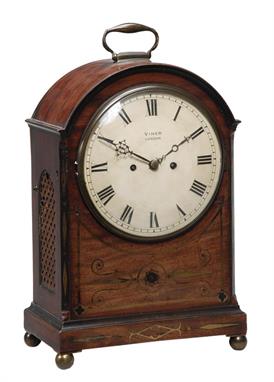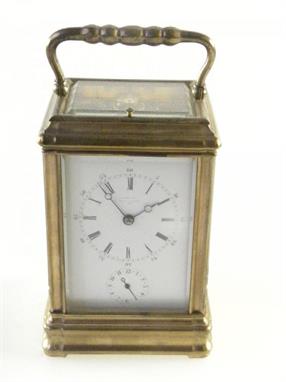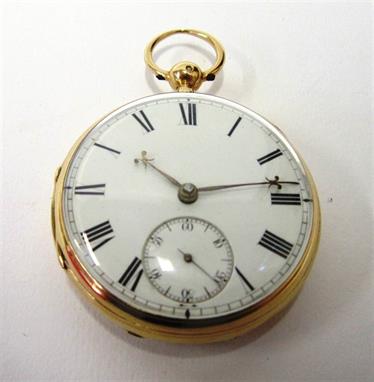A French brass carriage clock with alarm, Retailed by Barraud and Lund, London, late 19th century, The eight-day two train gong striking movement with silvered platform lever escapement and numbered 2805 to backplate, the rectangular white enamel Roman numeral dial indistinctly inscribed BARRAUD & LUND, 41 CORNHILL to centre, with blued steel moon hands and subsidiary alarm setting dial to lower margin, in a bevel glazed cannelee type case with hinged carrying handle, 15cm (6ins) high excluding handle Please note this clock does not have a push-button repeat, this is an error in the catalogue description
38842 Preisdatenbank Los(e) gefunden, die Ihrer Suche entsprechen
38842 Lose gefunden, die zu Ihrer Suche passen. Abonnieren Sie die Preisdatenbank, um sofortigen Zugriff auf alle Dienstleistungen der Preisdatenbank zu haben.
Preisdatenbank abonnieren- Liste
- Galerie
-
38842 Los(e)/Seite
A fine French brass petit sonnerie striking carriage clock with decorated porcelain panels, push-button repeat and alarm, Retailed by Anglo Swiss Watch Company, Calcutta, circa 1900, The eight-day two train movement ting-tang striking the quarters on two gongs and sounding the hour on the larger of the two, with silvered platform lever escapement and rectangular Roman numeral wooded landscape painted porcelain dial inscribed ANGLO SWISS WATCH Co., CALCUTTA, SWISS MADE to centre and with blued steel spade hands above subsidiary alarm setting dial flanked by painted huntsman on horseman opposing companion and hounds, the case with substantial hinged reeded baton handle above breakfronted raised cushion moulded top and inverted breakfronted cavetto cornice over fluted Corinthian column corner uprights and porcelain side panels each painted with a stag within woodland landscape, on cavetto moulded plinth base incorporating fluted band and squab feet, 17cm (6.75ins) high excluding handle
* A Regency brass inlaid mahogany bracket clock, Viner, London, early 19th century, The five pillar twin fusee bell striking movement with anchor escapement and signed Viner, London to the decorative border engraved shouldered backplate, the 8 inch circular cream painted Roman numeral convex dial with repeat signature VINER, LONDON to centre, strike/silent lever at twelve oclock and pierced steel hands set behind convex glazed cast brass bezel, the break-arch case with brass carrying handle and cavetto moulded cornice above stylised double tulip shaped motif centred shaped panel beneath dial flanked by repeating lozenge decorated ebony canted angles, the sides with arched brass fishscale sound frets, the rear with arch-glazed door, on cavetto moulded skirt base with open lozenge centred motif to front and brass ball feet, 42cm (16.5ins) high excluding handle. Charles Edward Viner is recorded in Baillie, G.H. Watchmakers & Clockmakers of the World as apprenticed in 1802 and gaining his freedom of the Clockmakers Company in 1813. He was elevated to Liveryman in 1819 and is thought to have died in 1840. He was a fine maker who worked from Regent Street and is best known for producing fine complex giant carriage clocks and small mantel clocks.
A fine George III mahogany longcase clock, Alexander Cumming, London, circa 1790, The five pillar rack and bell striking movement with deadbeat escapement and 12 inch silvered brass Roman numeral ogee-arch top dial with large subsidiary seconds dial and calendar aperture to centre, pierced steel hands and Arabic five minutes to outer track beneath N/S strike/silent lever at twelve oclock and signed Alexander Cumming, LONDON to arch, the case with ogee-arch shaped cavetto cornice over brass stop-fluted columns and rectangular foliate-pierced side frets to hood and flame figured block top door to trunk, on raised panel fronted plinth base with moulded double skirt, 195cm (77ins) high 119cm (86.25ins) high. Alexander Cumming was born in Edinburgh 1733 and initially worked as a clock and watchmaker in Inveraray. In 1757 Cumming, along with his brother James, was employed by Archibald Campbell, the third Duke of Argyll, to install the organ and supply a longcase clock for his new castle at Inveraray. Cumming subsequently moved to London (perhaps shortly after the death of his patron in 1761) and by 1763 had been appointed as a member of the commission to adjudicate Harrisons marine timekeeper. In 1765 Cumming presented his celebrated barograph clock for King George III before completing his best-known work on horology Elements of Clock and Watch Work Adapted to Practice in 1766. In 1781 he was made an Honoury Freeman of the Clockmakers Company and in the early 1790s retired to Pentonville from where he continued to write various papers including Observations on the effects which carriage wheels, with rims of different shapes, have on the roads published in 1797. Alexander Cumming died in 1814 leaving his business to his nephew, John Grant.
A fine and rare Charles II panelled oak quarter-chiming thirty-hour longcase clock, John Williamson, London, the movement circa 1683, the case circa 1672, The four finned pillar two-handed plated movement with anchor escapement and long pendulum to the four-wheel going train, the two-in-one hour and quarter hour strike/chiming train utilising large countwheel cut for both the hours and quarters planted on the backplate and with pump-action wheel to the front plate for positioning the hammer pin-wheel set along with the quarter hammer pivots within a separate brass carriage fitted to the inside of the frontplate to either peel on a nest of four bells for the quarters or strike the hour on a further larger bell, the 9.5 inch square brass dial with applied silvered seconds ring to the fine boldly engraved symmetrical flowering tulip and foliate decorated centre incorporating drapery cartouche signed John Williamson, Near Temple Barr, Londini Fecit towards lower margin within applied silvered Roman numeral chapter ring with stylised fleur-de-lys half hour markers and Arabic five minutes within the narrow outer minute track, with sculpted blued steel hands and applied winged cherub head cast brass spandrels to angles, in a fine panelled oak case with deeply moulded triangular pediment and tall scroll-lattice pierced frieze to both front and sides above glazed dial aperture and large side windows to hood, the trunk with convex throat over 46 inch full-width single fielded panel door, the base of the same width with simple waist moulding above conforming fixed shorter fielded panel and moulded skirt, 235cm (92.5ins) high. Provenance: From the estate of an esteemed antiquarian horologist, purchased at Sothebys, Bond Street, London, 4th April 2001 (lot 300). The movement and dial previously in a purpose-made ebony/ebonised case in a private collection in Derbyshire before passing in the 1950s to another private collector who in-turn sold it by auction in London in 1976. The current case was supplied for a short-duration movement and dial by John Wise for presentation to a London institution in 1672. The original dial by Wise was retained but the movement had been replaced (probably upgraded to eight-day duration) before being illustrated in Dawson, Percy G.; Drover, C.B. and Parkes, D.W. Early English Clocks on page 494 (plate 733). The clock as it is now is illustrated in Loomes, Brian BRASS DIAL CLOCKS on page 50 (plate 37).. The life and work of John Williamson is described in Loomes, Brian BRASS DIAL CLOCKS where it is noted that he was possibly born in 1651 at Guisley near Leeds and was probably related to the Barber family who worked as blacksmiths and clockmakers in nearby Otley. John Williamson moved to London and was admitted as a free Brother to the Clockmakers Company in December 1682, however records indicate that he only paid one months subscription to the Company and by December 1683 he had returned to Leeds to be married. Williamson continued making clocks in Leeds (very much in the London style) until after 1700 when the business is thought to have passed to his former apprentice, William Tipling. The movement and dial of the current lot belongs to a small group of short duration movements made by leading London makers during the late 1670s and early 1680s. The dial engraving can be compared to that seen on a key-wound thirty hour clock by Thomas Tompion formerly in the Wetherfield Collection illustrated in Cescinsky, Herbert and Webster, Percy English Domestic Clock (Fig. 77). The two-in-one strike/quarter-chiming train is similar in concept to those originally used by makers such as Fromanteel, William Clement and Joseph Knibb as it relies on a single countwheel cut for both the hours and quarters to control the running of the train. However it differs in that the pump-action that facilitates the switching between the operation of the hour and quarter hammers is achieved by moving the hammer pin-wheel rather than the hammer pivot arbors themselves. This system is inherently simple and is neatly incorporated between the plates by providing a separate cocked pivot plate for the pin wheel and hammer arbors. The case is rare example of one made by a non-specialist maker, with the construction and much of the detail being more typical of craftsman used to making vernacular furniture. It is also notable that the case has survived in fine condition with all of the original structure apparently intact, and is of rich colour. This is entirely commensurate with an easy life probably from spending most of its time residing in a London institution. The fact that both the case and movement can be individually accurately dated is highly unusual if not unique. Despite the ten year difference in age between the two the marriage of movement and dial into the current case is particularly successful, and allows both to be preserved as a fine useable examples.
A French brass five glass carriage clock, the white enamel dial set with Roman numerals inscribed "Hanhart & Co. Allahabad and Mussoorie French" CONDITION REPORTS Tarnish, wear, scuffs, chips to edges of glass, glass panels slightly loose. We can make no guarantees as to whether or not complete nor whether in working order. Height excluding handle approx 11cm
JAS THOMPSON, BATLEY, AN 18CT GOLD OPENFACED POCKET WATCH London 1874, the white enamel dial with black Roman numerals, number subsidiary seconds dial, gilt hands, the three piece hinged case housing a signed key wound movement with English lever escapement, numbered 41469, overall diameter approximately 5cm, in a small carriage clock case.
-
38842 Los(e)/Seite




























































